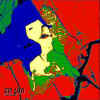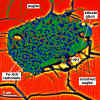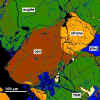Northwest Africa 998 the unique orthopyroxene-bearing nakhlite meteorite from the Planet Mars |
|
Northwest Africa 998 the unique orthopyroxene-bearing nakhlite meteorite from the Planet Mars |
|
Specimen SALES of this exquisite meteorite.
All photos and text are copyright and may not be used without permission. |
|
Click Images to enlarge: |
|
 |
NWA 998 is classified as an Orthopyroxene Nakhlite. The total weight found was 456 grams. The weight of the main mass, pictured here, is 165 grams. |
| This wedge-shaped specimen weighs 28 grams and measures 33.5mm by 30mm by 21mm. It is cut from the section of the meteorite with the thickest concentration of fusion crust. | |
| A close-up view of the surface of NWA 998 reveals a stunning surface studded with strikingly beautiful green and brown crystals. | |
 |
Another close-up view of the surface of NWA 998 taken through a microscope by just holding my digital camera up to the eye piece. Caution, this image is big (1022k) |
 |
Studied in polarized light, this thin section measuring 11 mm by 6 mm reveals a dazzling array of colorful silicate minerals. They include greenish olivine and black titanomagnetite, an oxide of iron and titanium. |
 |
Resembling an impressionistic portrait, this color-enhanced image is really a close-up electron view of NWA 998, about 20 microns across. The interlocking swirls suggest that the rock experienced a brief but intense geologic upheaval on Mars |
 |
This is an image of an extraterrestrial Fe-bearing carbonate found in NWA 998 Orthopyroxene-bearing Nakhlite. |
 |
This image shows a discrete crystal of Orthopyroxene, a major component of ALH84001, found in NWA 998. Several of these crystals exist and it is the first time ever found in a Nakhlite. All of the electron views shown here are courtesy of the University of Washington which performed the initial scientific work on this incredible meteorite. Currently, no less than 5 laboratories are intensely studying this meteorite. |
  Thin section photos by John Kashuba
Thin section photos by John Kashuba |
|
|
|
Thin section panorama of NWA 998 in cross polarized light, composed of 97 individual images; each image is composed of about 15 images varying focus which are "stacked" with zerene stacker. Zoom used was plan objectiive x10/0.25 and the camera was a 5MP CCD. See SOLAR ANAMNESIS for more information. |
|
|
| NWA 998 is also described as containing ankeritic carbonates. One other
meteorite has been described in this manner --- ALH84001, the most
famous Martian Meteorite in the world, which is at the center of the life on mars
controversy. ALH84001 was discovered in Antarctic in 1984. In August 1996 a
team of scientists announced that they believe they found evidence of ancient microbacterial life in
ALH84001. The debate still rages today, seven years after the stunning announcement.
Because of this stunning theory, Mars is the hottest area of interest in the solar
system and un-manned probes are currently enroute. Another scientifically important discovery with NWA 998 is the presence of water bearing minerals within the meteorite. This discovery strengthens the theory that Mars was once a wet planet capable of supporting life. The other Nakhlites have evidence of being altered by flowing water but only NWA 998 contains these water bearing minerals. NWA 998 is the most scientifically important meteorite to ever be discovered in the Sahara Desert. The unique announcements that have been revealed to date are just the beginning. Because of it's scientific importance, very little of NWA 998 will be available for private ownership. A once-in-a-lifetime meteorite discovery deserves to be made available primarily for study. There are only four Calcium poor Martian Meteorites in the world - ALH84001, Chassigny, Dhofar 378, and NWA 998. Read a report on NWA 998 on JPL Mars Meteorite homepage. New meteorite clues to life on Mars - Scientists believe they may have found fresh evidence of life on Mars in a meteorite that crashed to Earth. Microscopic strands were revealed inside the space rock, labelled NWA 998 when it was examined at the University of Toronto, Canada. Petrology and Isotopic Composition of Orthopyroxene-Bearing Nakhlite NWA 998 - from the 65th Annual Meteoritical Society Meeting July 2002. (link requires Adobe to view) Trace element geochemistry of New Nakhlites from the Antarctic and the Saharan Desert. - 34th Lunar and Planetary Science Conference, March 17 - 21, 2003. (link requires Adobe to view) Tungsten Isotopic Compositions of the SNC Meteorites: Further Implications for Early Differentation History of Mars. (link requires Adobe to view) Sims Analysis of Volatiles and H Isotope Studies of the Nakhlites Yamato 000593 Y00593) and North West Africa 998 (NWA 998 - From the Lunar and Planetary Science Meeting XXXVI 2005 (link requires Adobe to view)
Official Classification from the Meteoritical Bulletin #87 June, 2003:
A. and G. Hupe (Hupe) purchased from dealers at the Tucson Gem and Mineral Show in 2002 February the main mass from a 456 g stone that had been acquired at an unspecified site in western Algeria or eastern Morocco in 2001 September. Dimensions before cutting: 72 mm by 65 mm by 48 mm. Classification and mineralogy (A. Irving and S. Kuehner, UWS): a friable, dark green rock with minor orange-brown alteration products that probably are of pre-terrestrial origin. Composed mainly of subhedral, olive-green, complexly-zoned subcalcic augite (Fs22Wo39) with subordinate yellow olivine (Fa64), orthopyroxene (Fs49Wo4), interstitial plagioclase (Ab61Or4 containing 0.1 wt.% SrO, and exhibiting normal birefringence), titanomagnetite, chlorapatite and pyrrhotite. The overall texture is that of a hypabyssal, adcumulate igneous rock, and the apparent crystallization sequence is olivine, orthopyroxene, titanomagnetite, augite, apatite, plagioclase. There is a weak preferred orientation of prismatic pyroxene crystals, many of which have very distinctive zoning, with cores of augite surrounded by irregular, inverted pigeonite rims (now consisting of orthopyroxene with fine augite lamellae). Trains of tiny melt inclusions are present along healed fractures within pyroxene; microprobe study confirms that most of these are K-Na-Al-bearing silicate glass, but some are intergrowths of glass and Fe-bearing carbonate, which may represent quenched immiscible silicate- carbonate liquids. Symplectitic intergrowths of titanomagnetite and low-Ca pyroxene are present at grain boundaries between large, discrete olivine and titanomagnetite grains, but are not present around chromian titanomagnetite inclusions within olivine. These observations suggest that a pre-terrestrial oxidation process produced the symplectites, and involved high temperature, deuteric fluid infiltration along grain boundaries; such fluids also may have produced the irregular pigeonitic rims on augite crystals. Secondary (probably pre-terrestrial) ankeritic carbonate, K-feldspar (some Fe-bearing), (?)serpentine, calcite and a Ca sulfate are present on grain boundaries and within cracks in augite. Oxygen isotopes (D. Rumble, CIWGL*): replicate analyses of acid-washed augite by laser fluorination gave _18O = +3.9 _ 0.2, _17O = +2.4 _ 0.1, _17O = +0.30 _ 0.02 per mil. Specimens: type specimens, 20 g, UWS, 20 g, FMNH, and two polished thin sections, UWS; main mass, Hupe. [*Carnegie Institution of Washington, Geophysical Laboratory, Washington, DC, U.S.A.]
|